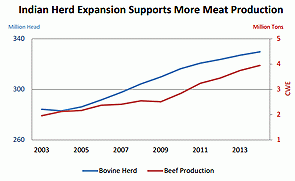
By Allan Barber
For a country where the cow is sacred to adherents of the majority Hindu religion, it seems surprising that India has overtaken Brazil as the largest exporter of beef in the world.
A recent article in the New Indian Express reports that a prime ministerial candidate, Narendra Modi, recently referred to the ‘pink revolution’ as the only revolution happening in India, signifying the growing importance of the country’s meat industry.
It was intended primarily as a dig at the inactivity of India’s ruling United Progressive Alliance party which has been in power since 2004.
But it underlines the point that beef exports have grown by 50% in the past five years to 1.89 million tonnes with main markets being USA, Europe, the Gulf States and South East Asia.
Poultry exports have also grown substantially, reaching 3.5 million tonnes in the latest year for which figures are available, which puts it after USA and Brazil as the world’s third largest exporter.
An official with India’s Department of Animal Husbandry says the country’s Agricultural and Processed Food Products Export Development Authority (APEDA), is out to improve the quality and safety requirements for both the domestic market and the export industry. In the last year, APEDA has approved 170 integrated abattoirs, slaughterhouses and meat processing plants across the country, apart from announcing subsidies worth `15 crore or nearly NZ$3 million to the modernising of abattoirs.
The USDA acknowledges that the government has played a crucial role in enhancing meat production and export. While a larger herd supports an increase in beef production, government programmes also encourage production.
For instance, the ‘Salvaging and Rearing of Male Buffalo Calves Scheme’ and the ‘Utilization of Fallen Animals’ improved carcass utilization programmes were incorporated in the government’s 11th Five Year Plan (2007-12) and will also be included in the 12th Five Year plan, according to the USDA’s annual report.
In India where cow slaughter is banned in many states on religious grounds, the size of the beef export trade and growth in processing plants may appear to be somewhat of an oxymoron.
However a large proportion of the beef trade is actually in buffalo beef as distinct from bos indicus or Brahman, the humped beef cattle typical of India and other warm climates.
Also slaughter is restricted to male and unproductive female animals.
For outside observers who consider the traditional Indian view is that cattle are sacred, as well as casting a suspicious eye over Indian slaughterhouses and processing facilities, this development will make them sit up and take notice of another emerging power in the global meat trade.
-------------------------------------------------------------------------------------------------------------------------------------------
Farms For Sale: the most up-to-date and comprehensive listing of working farms in New Zealand, here »
-------------------------------------------------------------------------------------------------------------------------------------------
Here are some links for updated prices for
- lamb
- beef
- deer
- wool
P2 Steer
Select chart tabs
---------------------------------------------------------------------------------------
Allan Barber is a commentator on agribusiness, especially the meat industry, and lives in the Matakana Wine Country where he runs a boutique B&B with his wife. You can contact him by email at allan@barberstrategic.co.nz or read his blog here ».

We welcome your comments below. If you are not already registered, please register to comment
Remember we welcome robust, respectful and insightful debate. We don't welcome abusive or defamatory comments and will de-register those repeatedly making such comments. Our current comment policy is here.